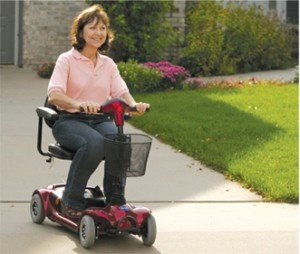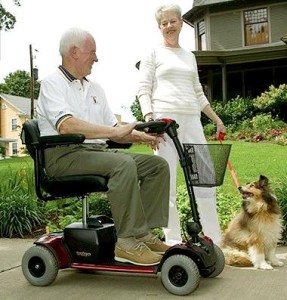Switching to a Power Chair in Daytona Beach, Florida
It’s hard to deny the fatigue and pain that may come from years of pushing a manual chair. Switching to a power chair actually could be the way to maintain that independence.
Symptoms & Signs:
 Accepting change is rarely easy. Many survivors in Daytona Beach, Florida choose to ignore the signals which indicate that a power chair would be appropriate for them. Picturing themselves in a power chair or admitting they might need one can be one of the most difficult adjustments for those with SCI. Physical therapists in Daytona Beach, Florida say there are three major issues that result in symptoms which cause people to make equipment changes: level of injury, number of years post injury and age. These three factors often interact, and they result in:
Accepting change is rarely easy. Many survivors in Daytona Beach, Florida choose to ignore the signals which indicate that a power chair would be appropriate for them. Picturing themselves in a power chair or admitting they might need one can be one of the most difficult adjustments for those with SCI. Physical therapists in Daytona Beach, Florida say there are three major issues that result in symptoms which cause people to make equipment changes: level of injury, number of years post injury and age. These three factors often interact, and they result in:
- lower strength or function.
- increased pain.
- decreased mobility.
- weight gain or loss.
- less activity.
- skin sores.
- posture problems.
- fatigue.
- aging of the primary care givers.
The stigma of disability keeps many people from changing or increasing equipment. Some find that they must let go of their ‘live for the moment’ attitude. Others, some of whom were injured during “the super quad” era when more equipment seemed to mean being “more disabled,” may struggle to accept the idea that changing equipment doesn’t mean going backwards. Some family members or friends need to be needed. They may need to hear that equipment changes such as power chairs can save shoulder muscles and joints, thus making more things possible in life.
It’s Not Always Obvious in Daytona Beach, Florida
Sometimes fatigue and pain can get in the way too slowly or gradually to notice. Power chairs allow people to do more things with less pain, less fatigue and more mobility, resulting in more independence.
It’s for Real!
 New research is indicating that over half of long-term SCI survivors are making equipment changes to preserve their mobility, their function, their independence, or to preserve the well-being of their caregivers and attendants. In a study of 279 British SCI survivors, all of whom had been injured at least 20 years, 59 % reported having made changes in durable medical equipment – new wheelchairs, lifts, cushions and hoists to ease transfers. Almost power chair 25 % listed fatigue and/or weakness as the cause for change in Daytona Beach, Florida.
New research is indicating that over half of long-term SCI survivors are making equipment changes to preserve their mobility, their function, their independence, or to preserve the well-being of their caregivers and attendants. In a study of 279 British SCI survivors, all of whom had been injured at least 20 years, 59 % reported having made changes in durable medical equipment – new wheelchairs, lifts, cushions and hoists to ease transfers. Almost power chair 25 % listed fatigue and/or weakness as the cause for change in Daytona Beach, Florida.
In this British research group, over 31 % of all those interviewed reported shoulder pain. Forty-seven percent had experienced postural changes, while 54 % were dealing with fatigue. Because SCI is not the static condition we once thought it was, the changes come. Forty percent of the 180,000 spinal cord injury survivors in the United States already are over 45; one in four has lived with injury power chair for over 20 years. Some feel that the changes of aging come sooner to people who have spinal cord injuries in Daytona Beach, Florida. Findings from the British study, where functional declines appeared in subjects in their late forties and early fifties, certainly support the belief of accelerated aging.
When Is It Time to Change to a Power Chair in Daytona Beach, Florida
- A personal inventory can be helpful in determining if a switch to a power chair is worth thinking about:.
- do you find yourself avoiding going certain places – places you used to want or go to go, but don’t – because it’s just too hard or simply not worth it?
- do you have persistent shoulder pain when wheeling?
- do you find yourself using more energy wheeling and not doing those things you want to do, like working, going out, entertaining or playing?
- do you have noticeably less fatigue and pain on days when you don’t wheel much?
Power chairs are big and bulky. Most don’t jump curbs. They do cost a lot of money. They are a hassle to travel with. The hassles of lifts and power chairs may be small potatoes compared to the hassles of needing an attendant or simply not being able to play or work at all. People use lots of reasons to avoid changing to a power chair – money, exercise, strength, travel. Often, their reluctance is really about not wanting to give in to aging and decline of function. Used equipment, family help, charitable organizations, Medicare or Medicaid can help pay for equipment. Different types of exercise can be less destructive to arms and shoulders, while preserving strength and stamina in Daytona Beach, Florida. Travel power chair can be more fun without fatigue. The costs of “hanging in there” and putting off getting new equipment may be greater than we had imagined, not just in money but in muscle pain, strength loss and general quality of life.
Prevention, Tradeoffs, & the Future of Power Chairs in Daytona Beach, Florida
Sometimes more equipment can prevent future problems and can mean more independence. Equipment changes in response to warning signals can help control or prevent chronic conditions such as scoliosis, carpal tunnel syndrome, degenerative shoulder disease or major muscle imbalances. Power wheelchairs and other power chair equipment changes can also serve to project a more positive, functional and independent image, as they are faster, more maneuverable and energy conserving. They may need permission power chair not to work so hard, not to be in so much pain, not to be so independent. While power chair changes in durable medical equipment can not totally prevent functional decline in all SCI survivors, they can minimize or delay power chair decline or the need for additional help.
Change rarely comes overnight and is often the result of trade-offs that are not readily apparent, like paying for fatigue with less time for kids, friends or other obligations, fewer hours on the job, or a major decline in social life power chair. Sometimes we simply need overwhelming evidence in order to know just how necessary change is.
When the price power chair for not changing is a clear decline in quality of life, then change may be easier to accept. No one has a power chair formula for how to figure this out – everyone is different. What is clear, though, is that survivors who have made the change to a power chair clearly report less pain and fatigue. If pain and fatigue from pushing a manual chair are ongoing problems and threats to independence in your life, a power power chair wheelchair may be a logical and appropriate response. They may power chair need to hear that equipment changes such as power chair can save shoulder muscles and joints, thus making more things possible in life.
People use lots of reasons to avoid changing to a power chair – money, exercise, strength, travel. Power wheelchairs and other equipment changes can also serve to project a more positive, functional and independent power chair image, as they are faster, more maneuverable and energy conserving. When the price for not changing is a clear decline in quality of life, then change may be easier to accept. What is clear, though, is that power chair survivors who have made the change to a clearly report power chair less pain and fatigue.
Looking for more health services nearby?